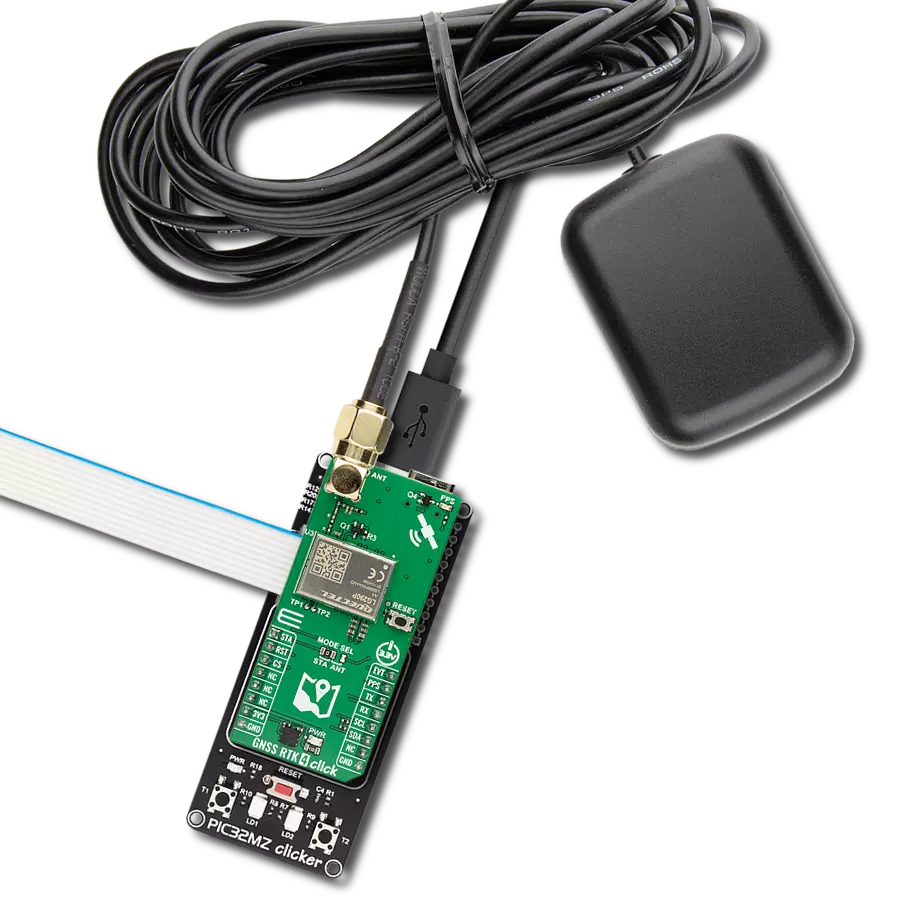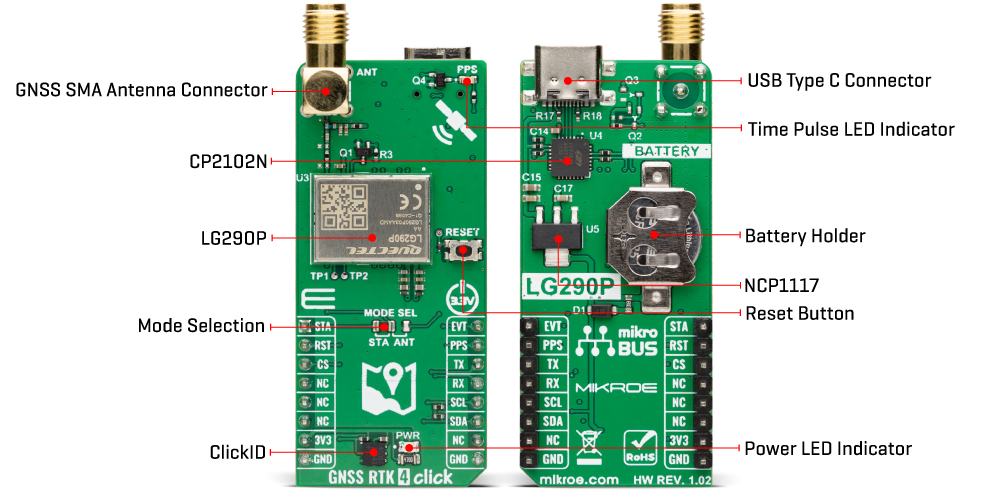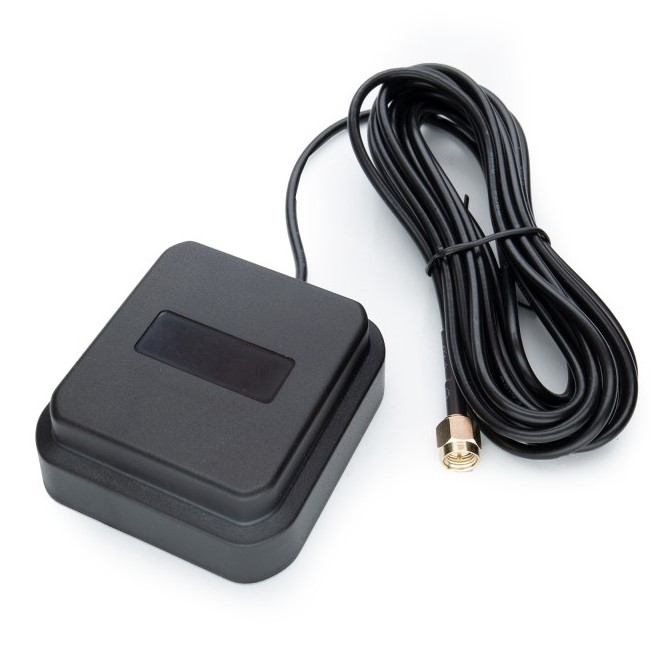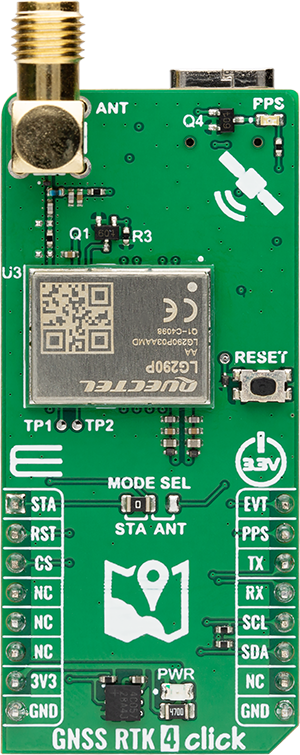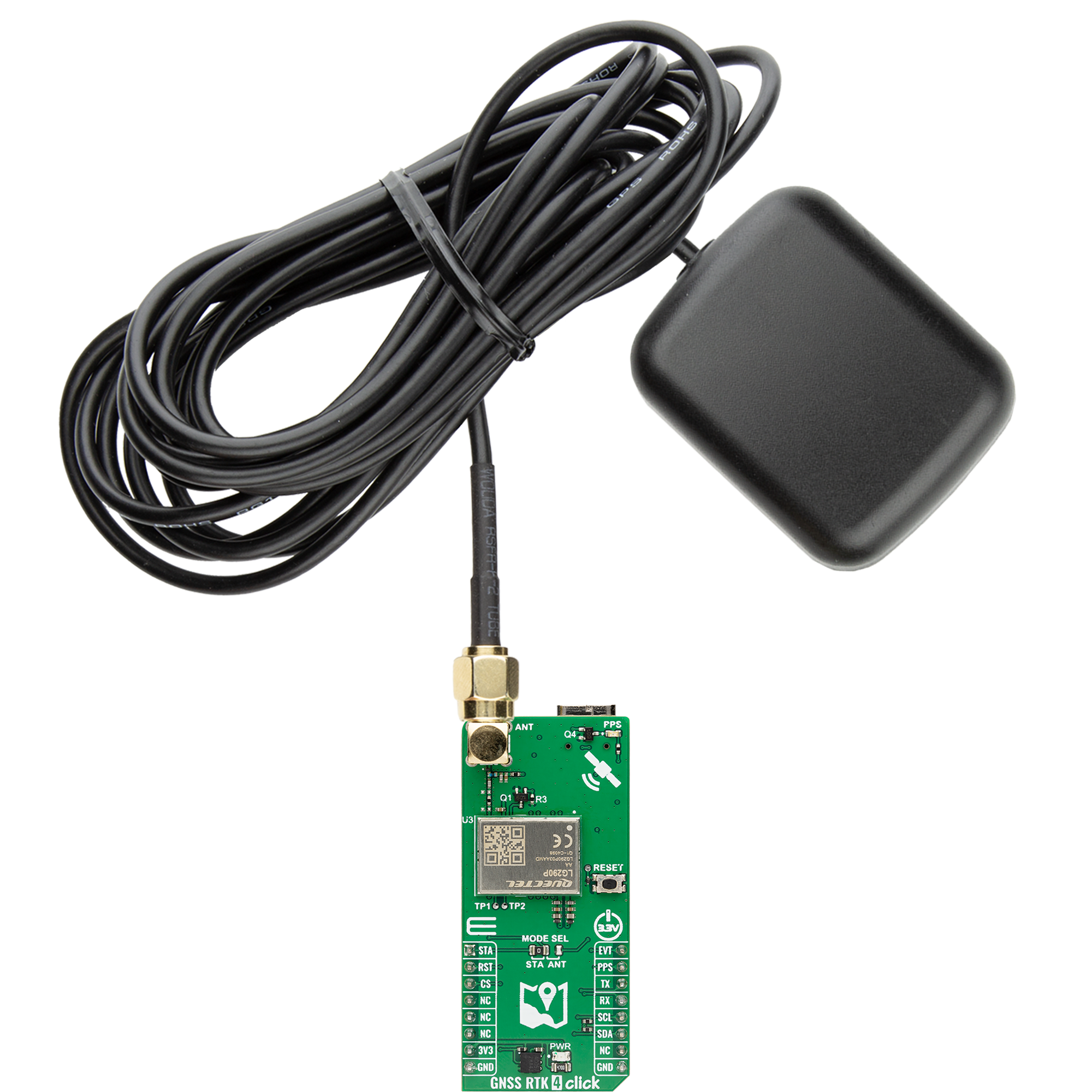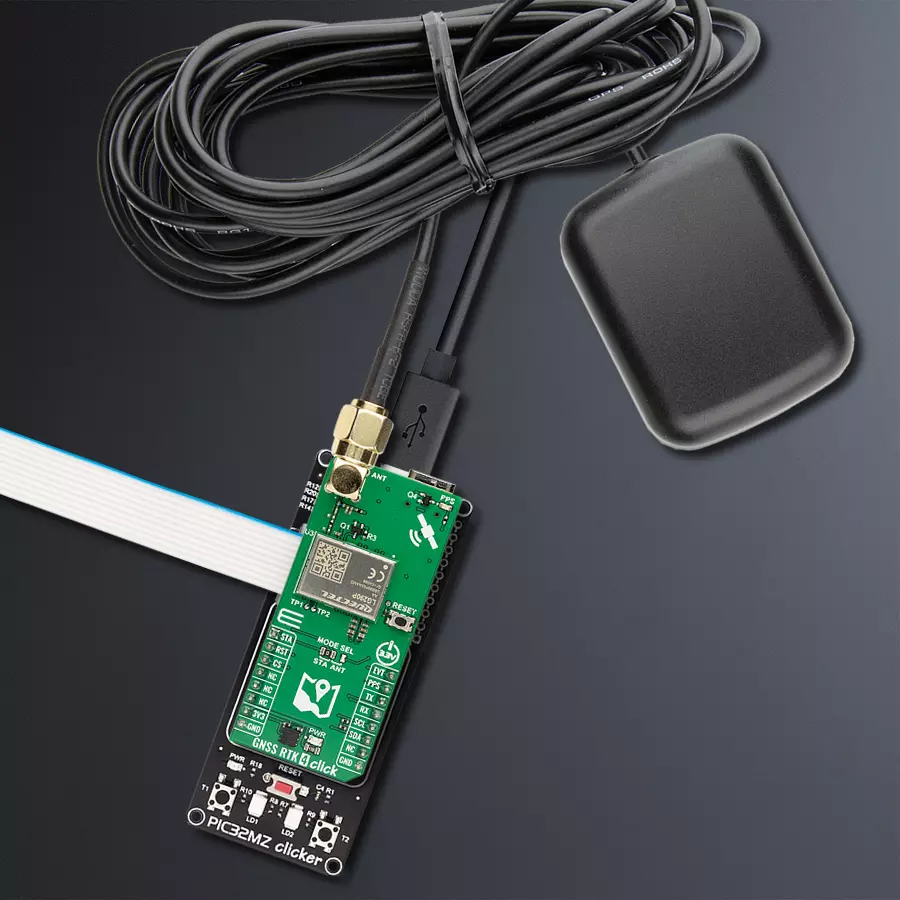Achieve sub-meter GNSS positioning with multi-band, multi-constellation RTK support and fast convergence
A
A
Hardware Overview
How does it work?
GNSS RTK 4 Click is based on the LG290P, a high-precision GNSS module from Quectel designed for multi-band RTK positioning and multi-constellation support. This module simultaneously receives signals from GPS, GLONASS, Galileo, BDS, QZSS, and NavIC while utilizing SBAS systems (WAAS, EGNOS, BDSBAS, MSAS, GAGAN, and SDCM) to enhance signal accuracy. Its advanced RTK algorithm enables rapid convergence and reliable sub-meter precision, making it ideal for precise navigation in urban areas, industrial applications, and challenging environments with dense foliage. To ensure optimal signal reception in electromagnetically complex environments, the LG290P integrates interference detection and elimination technologies, effectively mitigating multiple narrow-band interference sources. The module also supports multi-mode RTK algorithms, offering fast response times in high-precision positioning scenarios. Beyond positioning accuracy, the LG290P includes Secure Boot, on-chip storage with ECC verification, and integrity monitoring, ensuring firmware security and operational reliability. These features make it well-suited for autonomous navigation, UAVs, intelligent robotics, precision agriculture, surveying, and mining applications. This Click board™ uses the UART
interface as a main communication interface with an additional I2C interface with frequencies up to 400kHz for user-specific cases. It is important to note that firmware does not currently support this interface. Besides, the module also provides an additional UART interface via test points TP1 and TP2 that supports standard NMEA messages and debugging data. This board also includes a USB Type-C connector for USB 2.0 Full Speed capability, allowing for configuration via a PC. This functionality is enabled by the CP2102N, a USB-to-UART bridge, along with the NCP1117 LDO regulator, which converts the USB supply to the necessary 3.3V for the module, allowing for standalone configuration. In case of a power failure, the module can switch to a backup battery, ensuring continuous operation of the real-time clock (RTC) and battery-backed RAM. This preserves critical data and enables faster warm and hot starts. If no battery is present, the backup function is powered via the 3.3V rail of the mikroBUS™ socket. Besides the interface, the GNSS RTK 4 Click includes several pins for additional module control. The EVT pin provides event inputs with adjustable frequency and polarity, allowing for customizable input control. The STA pin indicates the RTK positioning status, where a HIGH
signal signifies that the module is in RTK fix mode, while a LOW signal indicates the module has exited RTK fix mode. This function is available if the MODE SEL jumper is set to the STA position, the default configuration. Alternatively, the STA pin controls the external LNA or active antenna power supply if set to the ANT position. It is important to note that firmware has not yet supported this ANT function. Additionally, the RST pin allows for resetting the module, a function that can also be performed using the onboard RESET button. The GNSS RTK 4 Click has an SMA antenna connector, marked ANT, for connecting an appropriate antenna, also offered by MIKROE, such as a GNSS L1/L5 Active External Antenna. This antenna is an excellent choice for all GNSS applications supporting L1 and L5 band frequencies. Also, the GNSS RTK 4 Click includes a yellow PPS LED indicator, which emits a synchronized pulse signal from the LG290P once per second. This Click board™ can be operated only with a 3.3V logic voltage level. The board must perform appropriate logic voltage level conversion before using MCUs with different logic levels. Also, it comes equipped with a library containing functions and an example code that can be used as a reference for further development.
Features overview
Development board
PIC32MZ Clicker is a compact starter development board that brings the flexibility of add-on Click boards™ to your favorite microcontroller, making it a perfect starter kit for implementing your ideas. It comes with an onboard 32-bit PIC32MZ microcontroller with FPU from Microchip, a USB connector, LED indicators, buttons, a mikroProg connector, and a header for interfacing with external electronics. Thanks to its compact design with clear and easy-recognizable silkscreen markings, it provides a fluid and immersive working experience, allowing access anywhere and under
any circumstances. Each part of the PIC32MZ Clicker development kit contains the components necessary for the most efficient operation of the same board. In addition to the possibility of choosing the PIC32MZ Clicker programming method, using USB HID mikroBootloader, or through an external mikroProg connector for PIC, dsPIC, or PIC32 programmer, the Clicker board also includes a clean and regulated power supply module for the development kit. The USB Micro-B connection can provide up to 500mA of current, which is more than enough to operate all onboard
and additional modules. All communication methods that mikroBUS™ itself supports are on this board, including the well-established mikroBUS™ socket, reset button, and several buttons and LED indicators. PIC32MZ Clicker is an integral part of the Mikroe ecosystem, allowing you to create a new application in minutes. Natively supported by Mikroe software tools, it covers many aspects of prototyping thanks to a considerable number of different Click boards™ (over a thousand boards), the number of which is growing every day.
Microcontroller Overview
MCU Card / MCU
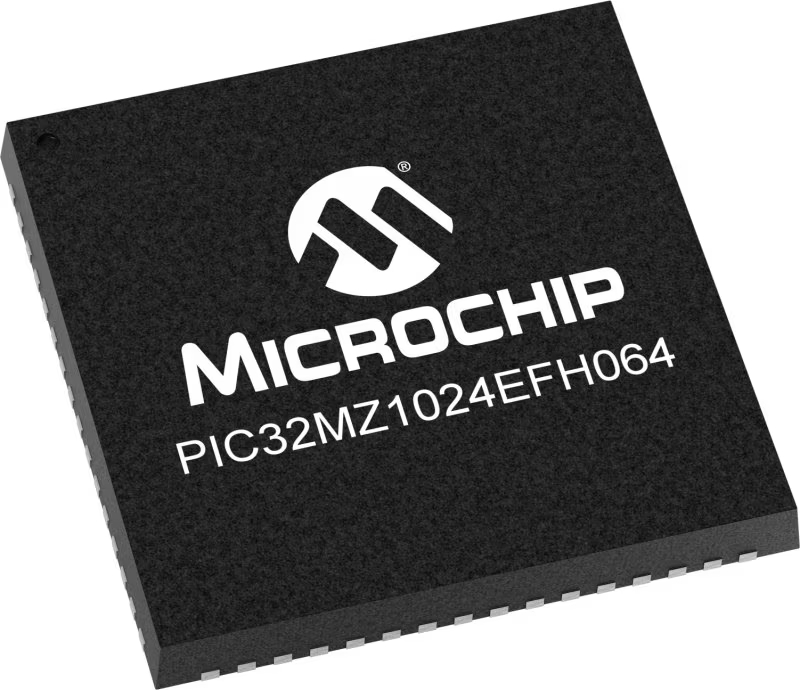
Architecture
PIC32
MCU Memory (KB)
1024
Silicon Vendor
Microchip
Pin count
64
RAM (Bytes)
524288
You complete me!
Accessories
GNSS L1/L5 Active External Antenna (YB0017AA) is an active patch antenna from Quectel that supports GNSS L1/L5 BD B1/B2 GLONASS L1, offering excellent performance with its high gain and efficiency for fleet management, navigation, RTK, and many other tracking applications. The magnetic-mounting antenna, with dimensions of 61.5×56.5×23mm, is designed to work with various ground plane sizes or in free space and is connected to the device by a 3m cable with an SMA male connector.
Used MCU Pins
mikroBUS™ mapper
Take a closer look
Click board™ Schematic
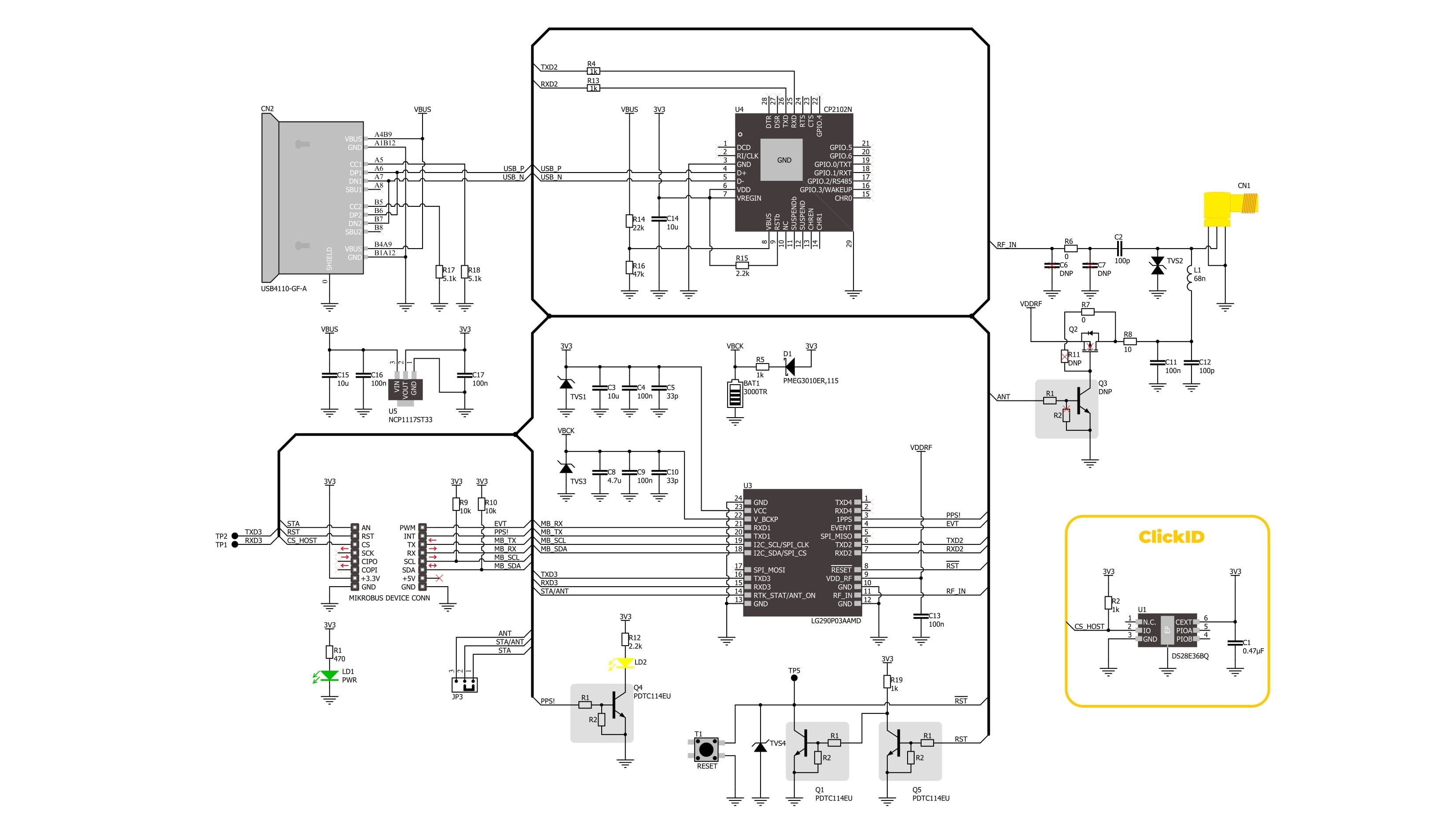
Step by step
Project assembly
Track your results in real time
Application Output
1. Application Output - In Debug mode, the 'Application Output' window enables real-time data monitoring, offering direct insight into execution results. Ensure proper data display by configuring the environment correctly using the provided tutorial.

2. UART Terminal - Use the UART Terminal to monitor data transmission via a USB to UART converter, allowing direct communication between the Click board™ and your development system. Configure the baud rate and other serial settings according to your project's requirements to ensure proper functionality. For step-by-step setup instructions, refer to the provided tutorial.

3. Plot Output - The Plot feature offers a powerful way to visualize real-time sensor data, enabling trend analysis, debugging, and comparison of multiple data points. To set it up correctly, follow the provided tutorial, which includes a step-by-step example of using the Plot feature to display Click board™ readings. To use the Plot feature in your code, use the function: plot(*insert_graph_name*, variable_name);. This is a general format, and it is up to the user to replace 'insert_graph_name' with the actual graph name and 'variable_name' with the parameter to be displayed.

Software Support
Library Description
GNSS RTK 4 Click demo application is developed using the NECTO Studio, ensuring compatibility with mikroSDK's open-source libraries and tools. Designed for plug-and-play implementation and testing, the demo is fully compatible with all development, starter, and mikromedia boards featuring a mikroBUS™ socket.
Example Description
This example demonstrates the use of GNSS RTK 4 Click by reading and displaying the GNSS coordinates.
Key functions:
gnssrtk4_cfg_setup- This function initializes Click configuration structure to initial values.gnssrtk4_init- This function initializes all necessary pins and peripherals used for this Click board.gnssrtk4_generic_read- This function reads a desired number of data bytes by using UART serial interface.gnssrtk4_parse_gga- This function parses the GGA data from the read response buffer.gnssrtk4_reset_device- This function resets the device by toggling the RST pin.
Application Init
Initializes the driver and logger.
Application Task
Reads the received data, parses the NMEA GGA info from it, and once it receives the position fix it will start displaying the coordinates on the USB UART.
Open Source
Code example
The complete application code and a ready-to-use project are available through the NECTO Studio Package Manager for direct installation in the NECTO Studio. The application code can also be found on the MIKROE GitHub account.
/*!
* @file main.c
* @brief GNSS RTK 4 Click Example.
*
* # Description
* This example demonstrates the use of GNSS RTK 4 Click by reading and displaying
* the GNSS coordinates.
*
* The demo application is composed of two sections :
*
* ## Application Init
* Initializes the driver and logger.
*
* ## Application Task
* Reads the received data, parses the NMEA GGA info from it, and once it receives
* the position fix it will start displaying the coordinates on the USB UART.
*
* ## Additional Function
* - static void gnssrtk4_clear_app_buf ( void )
* - static void gnssrtk4_log_app_buf ( void )
* - static err_t gnssrtk4_process ( gnssrtk4_t *ctx )
* - static void gnssrtk4_parser_application ( uint8_t *rsp )
*
* @note
* The Click board comes with the default baud rate of 460800, but the baud rate is set to 115200
* in the library due to code portability and speed limitations of some MCUs. So in order to run
* the example you will need to adjust the baud rate using Quectel QGNSS evaluation software.
*
* @author Stefan Filipovic
*
*/
#include "board.h"
#include "log.h"
#include "gnssrtk4.h"
// Application buffer size
#define APP_BUFFER_SIZE 500
#define PROCESS_BUFFER_SIZE 200
static gnssrtk4_t gnssrtk4;
static log_t logger;
static uint8_t app_buf[ APP_BUFFER_SIZE ] = { 0 };
static int32_t app_buf_len = 0;
/**
* @brief GNSS RTK 4 clearing application buffer.
* @details This function clears memory of application buffer and reset its length.
* @note None.
*/
static void gnssrtk4_clear_app_buf ( void );
/**
* @brief GNSS RTK 4 log application buffer.
* @details This function logs data from application buffer to USB UART.
* @note None.
*/
static void gnssrtk4_log_app_buf ( void );
/**
* @brief GNSS RTK 4 data reading function.
* @details This function reads data from device and concatenates data to application buffer.
* @param[in] ctx : Click context object.
* See #gnssrtk4_t object definition for detailed explanation.
* @return @li @c 0 - Read some data.
* @li @c -1 - Nothing is read.
* See #err_t definition for detailed explanation.
* @note None.
*/
static err_t gnssrtk4_process ( gnssrtk4_t *ctx );
/**
* @brief GNSS RTK 4 parser application.
* @details This function logs GNSS data on the USB UART.
* @param[in] rsp : Response buffer.
* @return None.
* @note None.
*/
static void gnssrtk4_parser_application ( uint8_t *rsp );
void application_init ( void )
{
log_cfg_t log_cfg; /**< Logger config object. */
gnssrtk4_cfg_t gnssrtk4_cfg; /**< Click config object. */
/**
* Logger initialization.
* Default baud rate: 115200
* Default log level: LOG_LEVEL_DEBUG
* @note If USB_UART_RX and USB_UART_TX
* are defined as HAL_PIN_NC, you will
* need to define them manually for log to work.
* See @b LOG_MAP_USB_UART macro definition for detailed explanation.
*/
LOG_MAP_USB_UART( log_cfg );
log_init( &logger, &log_cfg );
log_info( &logger, " Application Init " );
// Click initialization.
gnssrtk4_cfg_setup( &gnssrtk4_cfg );
GNSSRTK4_MAP_MIKROBUS( gnssrtk4_cfg, MIKROBUS_1 );
if ( UART_ERROR == gnssrtk4_init( &gnssrtk4, &gnssrtk4_cfg ) )
{
log_error( &logger, " Communication init." );
for ( ; ; );
}
log_info( &logger, " Application Task " );
}
void application_task ( void )
{
if ( GNSSRTK4_OK == gnssrtk4_process( &gnssrtk4 ) )
{
gnssrtk4_parser_application( app_buf );
}
}
int main ( void )
{
/* Do not remove this line or clock might not be set correctly. */
#ifdef PREINIT_SUPPORTED
preinit();
#endif
application_init( );
for ( ; ; )
{
application_task( );
}
return 0;
}
static void gnssrtk4_clear_app_buf ( void )
{
memset( app_buf, 0, app_buf_len );
app_buf_len = 0;
}
static void gnssrtk4_log_app_buf ( void )
{
for ( int32_t buf_cnt = 0; buf_cnt < app_buf_len; buf_cnt++ )
{
log_printf( &logger, "%c", app_buf[ buf_cnt ] );
}
}
static err_t gnssrtk4_process ( gnssrtk4_t *ctx )
{
uint8_t rx_buf[ PROCESS_BUFFER_SIZE ] = { 0 };
int32_t overflow_bytes = 0;
int32_t rx_cnt = 0;
int32_t rx_size = gnssrtk4_generic_read( ctx, rx_buf, PROCESS_BUFFER_SIZE );
if ( ( rx_size > 0 ) && ( rx_size <= APP_BUFFER_SIZE ) )
{
if ( ( app_buf_len + rx_size ) > APP_BUFFER_SIZE )
{
overflow_bytes = ( app_buf_len + rx_size ) - APP_BUFFER_SIZE;
app_buf_len = APP_BUFFER_SIZE - rx_size;
memmove ( app_buf, &app_buf[ overflow_bytes ], app_buf_len );
memset ( &app_buf[ app_buf_len ], 0, overflow_bytes );
}
for ( rx_cnt = 0; rx_cnt < rx_size; rx_cnt++ )
{
if ( rx_buf[ rx_cnt ] )
{
app_buf[ app_buf_len++ ] = rx_buf[ rx_cnt ];
}
}
return GNSSRTK4_OK;
}
return GNSSRTK4_ERROR;
}
static void gnssrtk4_parser_application ( uint8_t *rsp )
{
uint8_t element_buf[ 200 ] = { 0 };
if ( GNSSRTK4_OK == gnssrtk4_parse_gga( rsp, GNSSRTK4_GGA_LATITUDE, element_buf ) )
{
static uint8_t wait_for_fix_cnt = 0;
if ( strlen( element_buf ) > 0 )
{
log_printf( &logger, "\r\n Latitude: %.2s degrees, %s minutes \r\n", element_buf, &element_buf[ 2 ] );
memset( element_buf, 0, sizeof( element_buf ) );
gnssrtk4_parse_gga( rsp, GNSSRTK4_GGA_LONGITUDE, element_buf );
log_printf( &logger, " Longitude: %.3s degrees, %s minutes \r\n", element_buf, &element_buf[ 3 ] );
memset( element_buf, 0, sizeof( element_buf ) );
gnssrtk4_parse_gga( rsp, GNSSRTK4_GGA_ALTITUDE, element_buf );
log_printf( &logger, " Altitude: %s m \r\n", element_buf );
wait_for_fix_cnt = 0;
}
else
{
if ( wait_for_fix_cnt % 50 == 0 )
{
log_printf( &logger, " Waiting for the position fix...\r\n\n" );
wait_for_fix_cnt = 0;
}
wait_for_fix_cnt++;
}
gnssrtk4_clear_app_buf( );
}
}
// ------------------------------------------------------------------------ END
Additional Support
Resources
Category:GPS/GNSS
